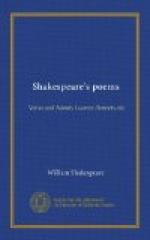|
This section contains 10,293 words (approx. 35 pages at 300 words per page) |

|
SOURCE: "Love as Trompe-l'oeil: Taxonomies of Desire in Venus and Adonis," in Shakespeare Quarterly, Vol. 46, No. 3, Fall, 1995, pp. 257-76.
In the essay, below, Belsey studies Venus and Adonis as a "literary trompe-l'oeil, a text of and about desire" that "promises a definitive account of love" but withholds it.
I
The painter Zeuxis excelled in the art of trompe-l'oeil, a mode of painting that is capable of deceiving the eye by its simulation of nature. Zeuxis portrayed grapes with such success that birds flew toward his picture. His younger rival, Parrhasius, however, challenged Zeuxis to a competition to decide which painter's work was more true to life. Parrhasius won—by depicting a curtain so convincing that Zeuxis begged him to draw it and reveal the picture behind.1 Jacques Lacan, in his seminar "Of the Gaze as Objet Petit a," makes a distinction between the two pictures: only the curtain...
|
This section contains 10,293 words (approx. 35 pages at 300 words per page) |

|


